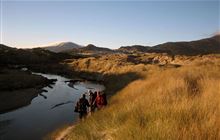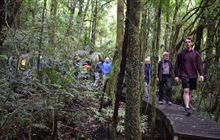What conservation boards do
Introduction
There are 15 conservation boards across Aotearoa, with up to 12 members each. Learn about the function of conservation boards and what it means to be a member.Conservation boards are independent bodies that empower local communities and iwi to contribute to the management of conservation areas. Boards provide a voice for local concerns to gain traction in DOC’s work, and on a national level where required.
This is achieved through their statutory functions, determined primarily under the:
as well as through their relationship with the New Zealand Conservation Authority (NZCA) and Department of Conservation.
The boards are involved in the review and monitoring of these statutory plans for their regions:
- conservation management strategies
- national park management plans, and
- conservation management plans.
Each of these statutory plans sets out how DOC and Treaty partners manage natural and historic heritage. The boards work with DOC to ensure the local communities are reflected in these plans.
Board members
Board members are appointed by the Minister of Conservation. Members are appointed as individuals for their experience, expertise, and links with the local community.
Anyone can be nominated, or nominate themselves, for a position on the board. The main criteria is an interest in conservation, and time and energy to take part. On any one board there may be students, teachers, farmers, fishers, scientists, builders, tourist operators, home makers, and people who are retired.
Members may have knowledge of nature conservation, natural earth and marine sciences, cultural heritage, recreation, tourism, the local community, and Māori perspectives.
Appointments commence on 1 July. Members serve a term of three years, although some members are appointed for a lesser term – often when replacing a resigning member. Members may be appointed for a second term.
Meetings and trips
The board will meet six times a year at various locations. A public forum session, where members of the public can talk to the board on conservation issues, is held during each meeting. These public conservation board meetings are an important mechanism for obtaining community input into conservation work and can contribute to a timely resolution of local issues. Field trips and workshops are sometimes integrated into these meetings, providing an opportunity to develop and acquire knowledge on local conservation issues.
Participation in the board is active. In addition to the meetings, trips, and workshops, members go to committee meetings, do research for reports and submissions, read briefing material before meetings, and liaise with the public. They work together to reach decisions by consensus.
Conservation boards and DOC benefit from the different perspectives that members offer, based on their personal and professional understanding.
All meeting agendas and minutes can be found on the individual Conservation board pages.
Code of Conduct
The Code of Conduct for conservation board members provides a framework for conservation boards’ successful operation. It includes the roles of the boards, responsibilities of board members, and key legislative functions.
Code of Conduct for conservation board members.
Payment
Conservation board members are paid for meetings and other approved activities. Members are paid a daily fee of $250, while the Chair fee is $330, based on an eight-hour commitment. The daily fee applies to all work, including that performed outside of meetings, that is required for the body to carry out its role.
Reasonable expenses for travel, accommodation, and meals approved in advance by the board will be reimbursed.
Relationship with the NZCA
The conservation boards draw the attention of the New Zealand Conservation Authority (NZCA) to matters which they believe may warrant consideration at a national level. This relationship is based on information sharing, consultation, and personal contact.
The NZCA has a liaison member for each conservation board. This liaison attends meetings and provides a means by which boards can communicate issues for the NZCA to consider on a national level. The NZCA can then communicate issues of high importance to the Minister of Conservation.
Relationship between conservation boards
Conservation boards liaise with their neighbouring boards. A culture of open information sharing is practiced, ensuring the best outcomes for conservation, with members often attending meetings of neighbouring boards.
Annual Chairs’ Conference
The Annual Chairs’ Conference takes place once a year, generally in late August, and provides an opportunity for the Chairs of all the conservation boards to meet and discuss issues of importance. The Minister of Conservation, Director-General of DOC, and the Chairperson of the NZCA, are usually in attendance at this conference.
More information
- Find your local conservation board to contact a board support officer.
- The Conservation Board Manual provides provides guidance for conservation boards in carrying out their duties and functions.
- 2013 Committee’s Report reviewing the role and function of conservation boards.




